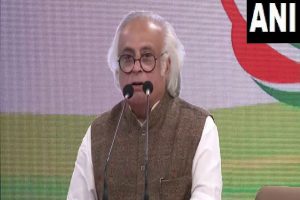‘Vulture Restaurant’! The name may sound creepy, but the intent is significant.
It is a feeding station for vultures in the Pong Dam Lake Wild Life sanctuary in Kangra district of Himachal Pradesh, which has been set up as a part of state wildlife wing’s ongoing project to conserve the big scavenging bird in natural habitat, whose numbers showed a critical decline in the past decades in Indian sub-continent.
Measuring 100 meters x 100 meters with seven feet high fencing at an open space in Suknara near Nagrota Surian in Pong wetland, the ‘Vulture Restaurant’ provides deskinned carcasses to vultures.
The wildlife wing facilitates the people in villages around to bring dead livestock to the place for feeding vultures. “De-skinning is done to make the carcass easily accessible to vultures. We have also erected wooden poles in the fenced area for vultures to sit,” Pradeep Thakur, Chief Conservator, Wild Life, Dharamshala with Himachal Pradesh Forest department told The Statesman.
He said vultures around the area gather fast at the feeding station when they smell or sight dead animals.
The vulture feeding station was built in 2008 in a bigger space (150 m x 150 m) at Suknara, but there were loopholes in the initial design, wherein other animals like dogs and jackals would also enter into it easily. In 2018, the feeding station was shifted one kilometer away and the design was improvised to make it exclusively for vultures. “The new station was named ‘Vulture Restaurant’ on a suggestion,” said Thakur.
He said there are three more such feeding stations in Kangra district. “The local community is involved in it and people can bring the dead livestock between 10 to 4 PM in the Vulture Restaurant.”
The wildlife officer said the concept of ‘Vulture Restaurant’, along with other steps, has not only given encouraging results in terms of conservation but has also become a preferred point for researchers.
“Many science students from Universities all around visit the place for firsthand experience on vulture species and behavior,” he said.
Vultures play an important role in ecology and are beneficial for humans. They are obligate scavengers as they eat flesh of dead animals, which on decay emit foul smell and spread diseases. Vultures are however most vulnerable scavengers as they have a low reproductive rate (one egg in a year) and face many threats in the Indian sub-continent, right from veterinary drug diclofenac, poisoning of carcasses with rodent pesticides or damage by wolves and foxes.
For all these reasons, the vulture population reportedly dropped manifold in the Indian subcontinent a few decades back.
Thakur revealed that the project on vulture conservation in natural habitat began in 2004 in Kangra district, and since then the population of vultures has shown an increase. Official data showed 26 nests and 23 fledglings (baby vultures) in 2004 in Kangra district, which increased to 387 nests and 352 fledglings in 2018-19.
He said Kangra district was picked up for the project as it had the highest population of livestock.
In the project, the wildlife wing carried out studies to record the nests of vultures and did need-based interventions to protect them. Steps were taken to reduce forest fires as the vultures had their nests in tall Chir Pine trees (which are prone to fire).
There are seven species of vultures in the new world and 16 species in the old world that includes Europe, Africa, Asia, Australia, etc. Out of 16 in the old world, eight species (including Himalayan Griffon, Eurasian Griffon) have been reported in Kangra district also.











